Last Updated on 5 months by admin
Goldfish, known for their vibrant colors and graceful swimming, are not just beautiful to look at, but they also play a role in pest control. One common question that arises is whether goldfish eat mosquito larvae, the small organisms that can cause annoyance and transmit diseases like the West Nile virus.
The answer is a resounding yes! Goldfish do indeed feast on mosquito larvae, making them valuable allies in the battle against these pesky insects. Whether you have a small goldfish in a bowl or a pond with a variety of goldfish breeds, they all share a common appetite for mosquito larvae.
Key Takeaways:
- Goldfish are known to eat mosquito larvae, helping to control mosquito populations.
- Mosquitoes are not only a nuisance but also pose a risk of diseases like West Nile virus.
- Goldfish, regardless of their size, can consume mosquito larvae.
- Other fish species like mosquito fish, minnows, koi, and guppies also feed on mosquito larvae.
- Feeding goldfish with mosquito larvae can be a natural and effective way to reduce mosquito breeding and population.
The Importance of Controlling Mosquitoes
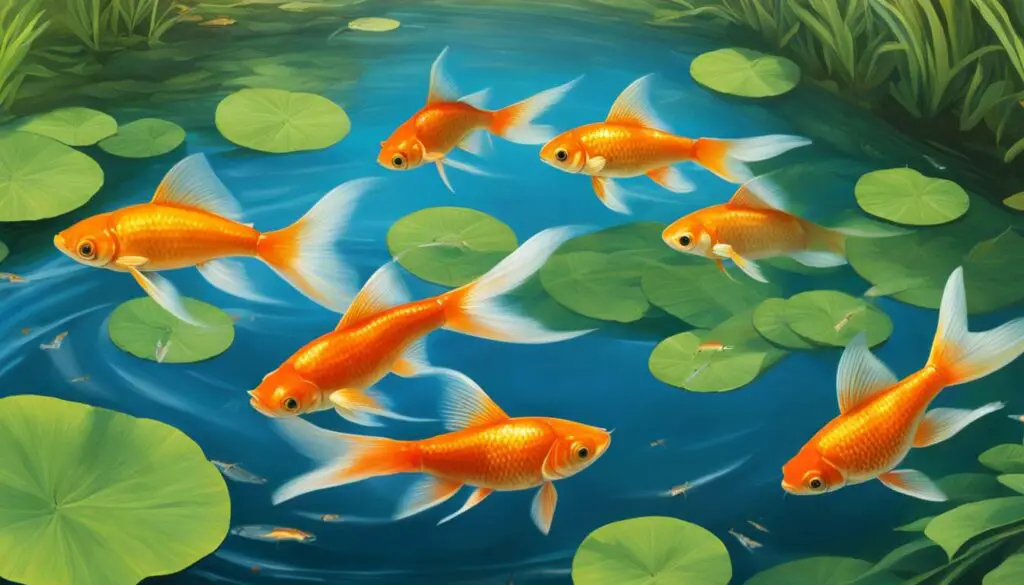
Mosquitoes are not only annoying but can also pose health risks by transmitting diseases. It is important to control their populations to protect oneself from diseases like West Nile virus, dengue, and yellow fever. Implementing natural mosquito control methods, such as encouraging the presence of mosquito-eating fish like goldfish, can help reduce mosquito breeding and population.
Benefits of Natural Mosquito Control
Implementing natural mosquito control techniques provides several benefits:
- Reduces the use of harmful chemical pesticides
- Promotes ecological balance
- Preserves the natural habitat
- Minimizes the risk of chemical exposure to humans and pets
- Offers a sustainable solution for long-term mosquito control
By utilizing natural methods, you can tackle mosquito populations while minimizing the negative impact on the environment and human health.
Biological Control of Mosquitoes
One effective approach to mosquito control is biological control, which relies on the introduction of natural predators to target mosquitoes and their larvae. Mosquito-eating fish, such as goldfish, can serve as a biological control agent.
“Goldfish are voracious feeders and consume mosquito larvae, effectively reducing their numbers. This biological control method provides a sustainable and environmentally friendly solution to combat mosquitoes.”
Goldfish are known for their ability to consume large quantities of mosquito larvae, preventing them from developing into adult mosquitoes. Their predatory behavior helps break the mosquito life cycle, reducing mosquito populations and the associated threat of diseases.
The Role of Goldfish in Natural Mosquito Control
Goldfish have adapted well to various aquatic environments, making them ideal for natural mosquito control. Here are a few reasons why goldfish are effective mosquito predators:
- Goldfish are active foragers, readily hunting and consuming mosquito larvae.
- They are adaptable and can thrive in a wide range of water conditions, making them suitable for different habitats.
- Goldfish can consume large amounts of mosquito larvae, contributing to significant reduction in mosquito populations.
- They serve as a natural alternative to chemical-based mosquito control methods, offering a safer and more sustainable approach.
By incorporating goldfish into water features like ponds, fountains, and water gardens, you can establish a natural mosquito control system that provides long-term protection against mosquito-borne diseases.
Mosquito Control with Goldfish: A Visual Comparison
Let’s compare the effectiveness of different mosquito control methods:
| Mosquito Control Method | Effectiveness | Eco-Friendliness | Longevity |
|---|---|---|---|
| Chemical Pesticides | Immediate impact | Environmental risks | Short-term solution |
| Mosquito Nets | Prevent mosquito bites | Environmentally friendly | Temporary protection |
| Goldfish as Biological Control | Significantly reduces mosquito populations | Environmentally friendly | Long-term solution |
As seen in the table above, using goldfish as a biological control method for mosquitoes provides a sustainable and effective long-term solution. Unlike chemical pesticides that may have negative environmental impacts and only offer short-term relief, goldfish actively target mosquito larvae and help prevent mosquito-borne diseases.
Creating a Mosquito-Friendly Environment for Goldfish

When it comes to keeping mosquito populations in check, goldfish can be valuable allies. To ensure a mosquito-friendly environment for goldfish, it is essential to provide suitable water conditions that support their health and well-being.
Goldfish prefer to inhabit clean, well-oxygenated water. By maintaining the water quality, you can prevent the formation of mosquito breeding grounds.
One effective way to promote water circulation and oxygenation in ponds or water features is by using a solar pump. Apart from being energy-efficient, solar pumps help in maintaining a clear and healthy environment for goldfish.
In addition to feeding on mosquito larvae, goldfish have a diverse diet. They are known to consume natural foods such as algae and insects.
Benefits of Creating a Mosquito-Friendly Environment for Goldfish:
“By creating a suitable habitat that supports the natural diet and behaviors of goldfish, you not only enable them to act as mosquito eaters but also contribute to their overall well-being.”
Understanding the importance of creating a favorable environment for goldfish is vital in ensuring their efficiency as mosquito eaters. By providing clean, well-oxygenated water and offering a varied diet, you can help these beautiful fish thrive while assisting in mosquito control.
| Benefits of a Mosquito-Friendly Environment for Goldfish: | Effective Mosquito Control | Diverse Diet |
|---|---|---|
| Supports the health and well-being of goldfish | Prevents formation of mosquito breeding grounds | Includes natural foods like algae and insects |
| Improves water quality in ponds and water features | Reduces mosquito populations | Promotes balanced nutrition for goldfish |
| Enhances the natural behavior and feeding patterns of goldfish | Contributes to overall well-being of goldfish |
Collecting Mosquito Larvae for Goldfish Fry
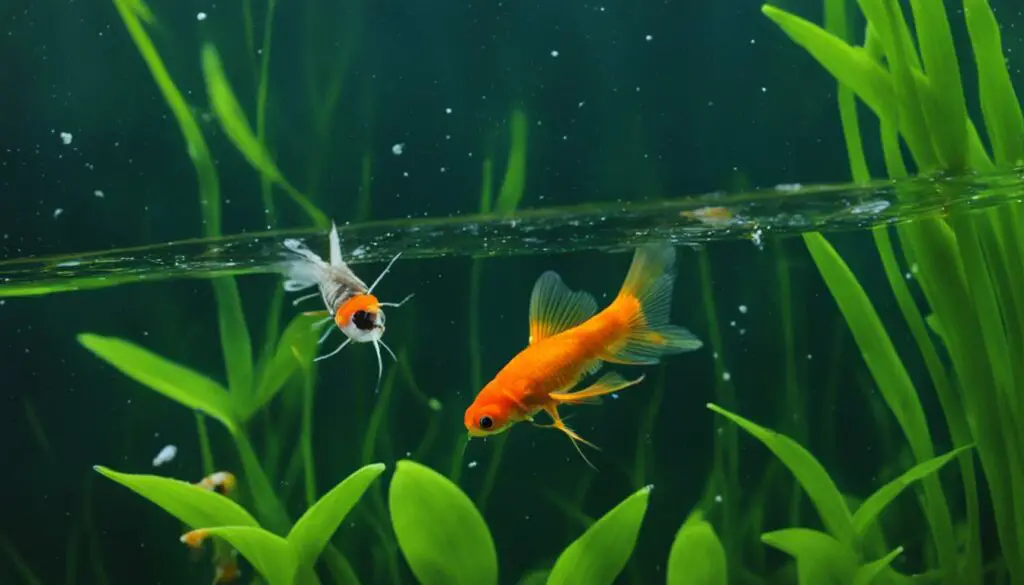
Mosquito larvae can be a valuable food source for goldfish fry, providing them with essential nutrients for growth and development. Collecting mosquito larvae is a simple and effective way to ensure a natural and nutritious diet for these young goldfish.
To collect mosquito larvae, create a small pool of water in a shallow container such as a bucket or a tub. Add rotting vegetable matter or a small amount of milk to attract female mosquitoes. The stagnant water and organic matter will serve as a breeding ground for mosquitoes.
Once the mosquitoes lay their eggs, which are small and oval-shaped, they will hatch into wrigglers within a few days. These tiny wrigglers are the mosquito larvae that goldfish fry can feed on. Carefully transfer the wrigglers into the fry aquarium, ensuring a constant supply of fresh mosquito larvae.
As the goldfish fry grow, it is important to adjust the size of the mosquito larvae to match their increasing appetite and nutritional needs. Gradually introduce larger wrigglers or move on to other natural food sources suitable for their size and development.
This method of collecting mosquito larvae for goldfish fry not only promotes their healthy growth but also aids in pest control by reducing the mosquito population. It is a natural and sustainable approach that benefits both the goldfish and the surrounding environment.
Benefits of Collecting Mosquito Larvae for Goldfish Fry
- Provides a nutritious food source for goldfish fry
- Promotes healthy growth and development
- Reduces mosquito population and aids in pest control
- Sustainable and natural approach
Goldfish Fry Mosquito Larvae Feeding Schedule
| Stage | Feeding |
|---|---|
| Spawn | Mosquito larvae, small and easily consumed food |
| Post-spawn | Mosquito larvae, gradually increasing in size |
| Fry | Nutritious food sources appropriate for their size and development |
Other Fish Species That Eat Mosquito Larvae
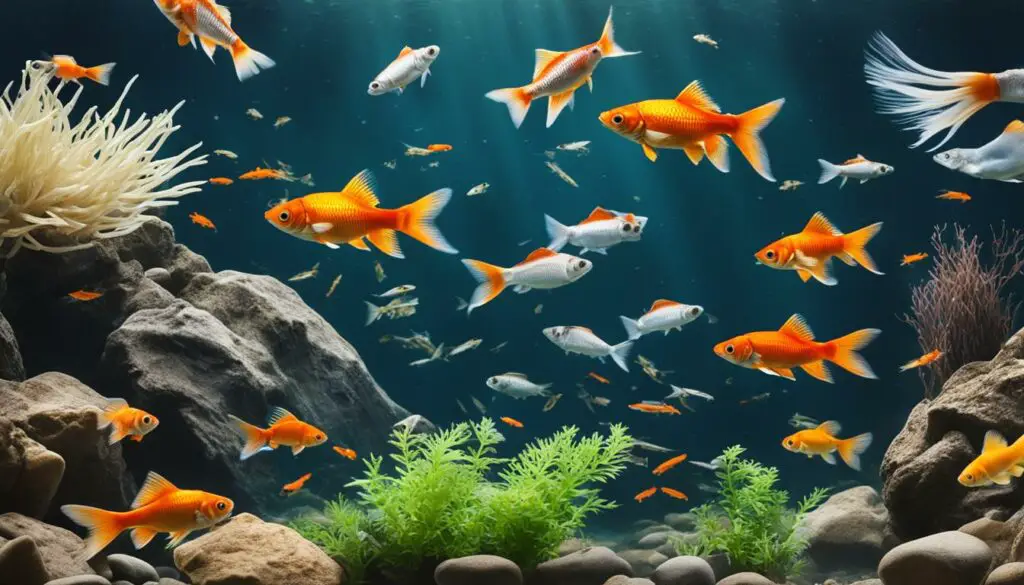
While goldfish are known to eat mosquito larvae, there are other fish species that also feed on them. These fish species can be effective in disrupting the mosquito life cycle and reducing their numbers in water environments.
Mosquitofish
Mosquitofish, also known as Gambusia, are small freshwater fish that are highly effective in controlling mosquito populations. They have a voracious appetite for mosquito larvae and can consume large quantities of them. Mosquitofish are hardy and adaptable, making them an ideal choice for mosquito control in ponds, water gardens, and other water features.
Minnows
Minnows, such as Fathead minnows and Rosy-red minnows, are another fish species that can help control mosquito populations. They are small, schooling fish that can consume mosquito larvae as part of their natural diet. Minnows are easy to maintain and can be introduced to ponds and other water bodies to reduce mosquito breeding.
Koi
Koi, beautiful ornamental fish, are not only admired for their vibrant colors but also for their appetite for mosquito larvae. These larger fish species can consume mosquito larvae and other small aquatic insects, helping to keep mosquito populations in check. Koi are commonly found in decorative ponds and are prized for their grace and elegance.
Guppies
Guppies, small and colorful tropical fish, are known for their ability to reproduce rapidly. Apart from their reproductive capabilities, guppies also have a taste for mosquito larvae. In addition to providing aesthetic value, guppies can be an effective natural solution to control mosquito populations in smaller water features like birdbaths and fish tanks.
Sailfin Mollies
Sailfin mollies, also called Mexican sailfin mollies, are a popular choice for controlling mosquito larvae in backyard ponds and aquariums. These fish species have a robust appetite for mosquito larvae and can consume them at a rapid pace. Sailfin mollies are peaceful and easy to care for, making them an excellent addition to any mosquito control strategy.
Killifish
Killifish, with their vibrant colors and unique patterns, are not only attractive but also effective mosquito control agents. They are small and aggressive fish that can consume mosquito larvae, as well as other tiny aquatic organisms. Killifish thrive in a variety of aquatic habitats and can be introduced to ponds and water gardens to help reduce mosquito populations.
By incorporating these fish species into your water feature or aquarium, you can create a balanced ecosystem that naturally controls mosquito populations. These fish, alongside goldfish, play a crucial role in reducing the number of mosquitoes and the associated health risks they bring.
Mosquito Breeding Habits and Lifecycle
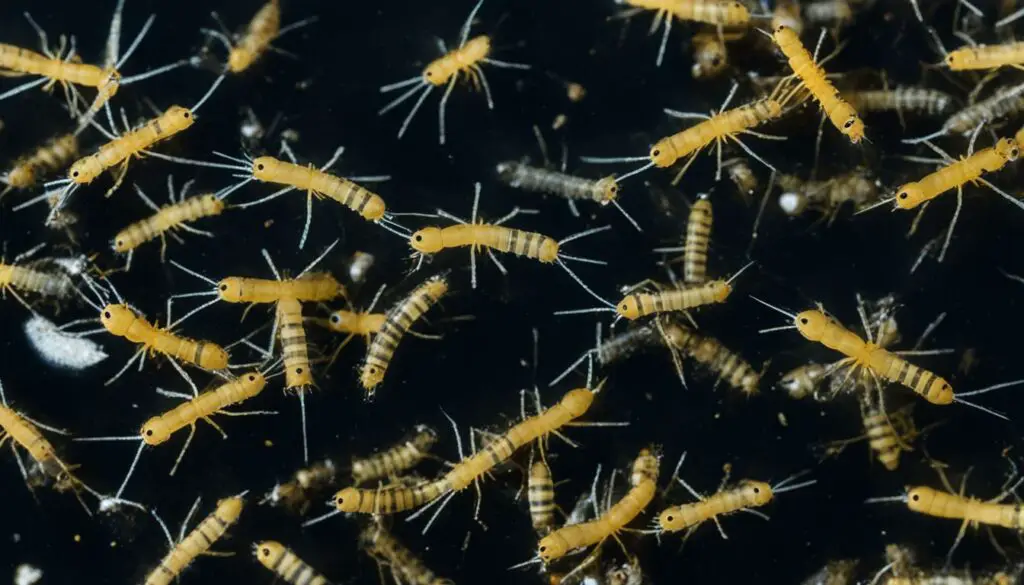
Mosquitoes are notorious for breeding in stagnant water, which can be found in various common areas such as wet gutters, buckets, potholes, and birdbaths. It is in these stagnant water sources that female mosquitoes lay their eggs, starting the mosquito lifecycle.
Once the eggs are laid, they hatch into mosquito larvae, commonly known as wrigglers. These larvae remain in the water, feeding on bacteria, fungi, and algae present in their aquatic environment. This feeding process helps them grow and develop into the pupal stage.
The pupal stage is a critical stage in the mosquito lifecycle, during which the larvae transform into adult mosquitoes. While in this stage, the pupae do not feed and are often found floating on the water surface. After a few days, the fully developed adult mosquitoes emerge from the pupae and become airborne.
Understanding the mosquito lifecycle is essential in implementing effective biological control measures to manage mosquito populations. By targeting mosquito larvae, such as the ones found in stagnant water sources, we can disrupt their development and reduce the number of adult mosquitoes. One effective method of biological control is through the introduction of mosquito-eating fish like goldfish.
Goldfish play a crucial role in the biological control of mosquitoes by consuming mosquito larvae, thereby preventing them from reaching the adult stage. This natural form of pest control can significantly reduce the mosquito population in water environments, contributing to a safer and more enjoyable outdoor experience.
| Mosquito Lifecycle Stages | Description |
|---|---|
| Egg | Female mosquitoes lay eggs in stagnant water sources. |
| Larva | The hatched mosquito eggs develop into larvae, which feed on bacteria, fungi, and algae in the water. |
| Pupa | Larvae transform into pupae, during which they do not feed and develop into adult mosquitoes. |
| Adult | After a few days, adult mosquitoes emerge from the pupae and become airborne. |
The Role of Fish in Mosquito Control
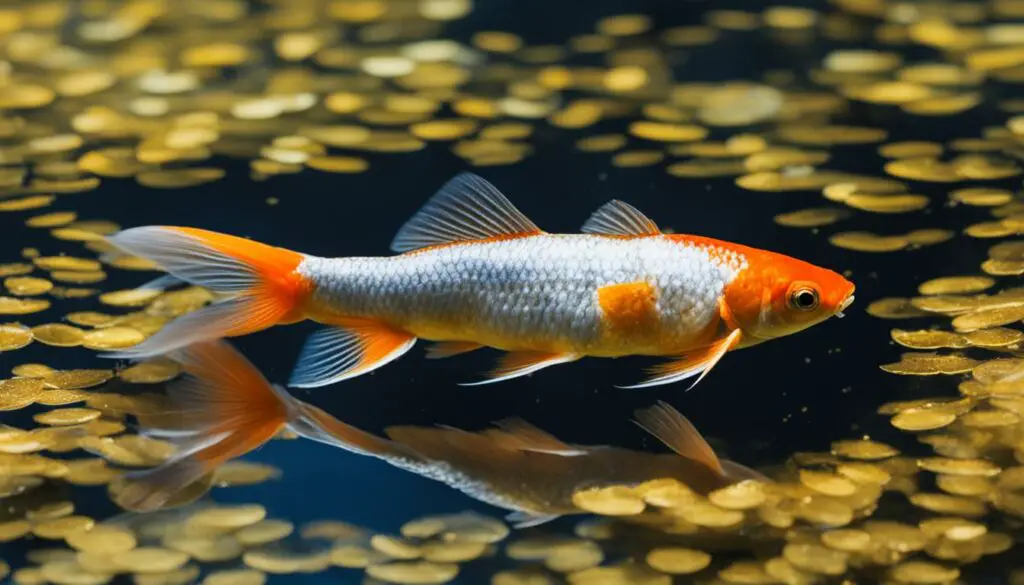
Fish, including goldfish, play a crucial role in the biological control of mosquito populations. They act as natural predators, feeding on mosquito larvae and preventing them from developing into adult mosquitoes. By stocking water environments with mosquito-eating fish, such as goldfish, the mosquito lifecycle can be disrupted, and their numbers can be significantly reduced.
In addition to goldfish, there are other fish species that are effective in controlling mosquito populations. Some of these species include:
- Mosquitofish
- Guppies
- Killifish
These fish species are known for their voracious appetites for mosquito larvae, making them valuable allies in the fight against mosquitoes. By introducing these fish into water environments, the biological control of mosquitoes can be enhanced.
| Fish Species | Prey | Advantages |
|---|---|---|
| Goldfish | Mosquito larvae, algae, insects | Can adapt to a wide range of water conditions, effective mosquito control |
| Mosquitofish | Mosquito larvae | High reproductive rate, aggressive feeders |
| Guppies | Mosquito larvae, small insects | Colorful addition to water features, efficient mosquito control |
| Killifish | Mosquito larvae, small invertebrates | Adaptability to various water conditions, effective mosquito control |
These fish species, including goldfish, contribute to the overall balance of aquatic ecosystems by controlling mosquito populations through natural means. The presence of these fish in water environments offers a sustainable and environmentally-friendly approach to mosquito control.
Additional Mosquito Control Measures
In addition to fish, there are other measures that can be taken to control mosquito populations. Implementing natural mosquito control methods is essential for creating a safer and more enjoyable outdoor environment. Here are some effective strategies to consider:
1. Emptying and maintaining outdoor containers:
Regularly emptying and maintaining containers such as buckets, flower pots, and bird baths can prevent stagnant water from becoming breeding grounds for mosquitoes. By eliminating potential mosquito habitats, you can greatly reduce their population.
2. Using floating fountains or submersed aerators:
Installing floating fountains or submersed aerators in ponds or water features helps prevent stagnant water by promoting water circulation and aeration. Mosquitoes prefer stagnant water for breeding, so enhancing water movement can deter their reproduction.
3. Establishing a beneficial shoreline buffer:
Creating a beneficial shoreline buffer, with the use of aquatic plants and natural vegetation, can help intercept debris and promote proper pond circulation. This buffer zone prevents the accumulation of stagnant water and reduces mosquito breeding areas.
4. Targeting mosquito larvae without harming beneficial insects:
In areas where maintaining standing water is problematic, such as gutters and rain barrels, using specific products that target mosquito larvae without harming beneficial insects can be an effective control measure. These products are designed to disrupt mosquito development while sparing helpful organisms.
By implementing these additional mosquito control measures alongside natural methods such as stocking water bodies with mosquito-eating fish, you can effectively reduce mosquito populations and create a more enjoyable outdoor environment.
Conclusion
Goldfish can play a pivotal role in controlling mosquito populations by consuming their larvae. These lively aquatic creatures are not picky eaters and readily consume mosquito larvae, alongside other natural foods such as algae and insects. By creating a mosquito-friendly environment with suitable water conditions and introducing mosquito-eating fish like goldfish, we can effectively disrupt the mosquito lifecycle, reducing their numbers and the associated risk of diseases they carry.
Goldfish, known for their resilience and adaptability, can thrive in various water features, including ponds, fountains, and water gardens. Incorporating them into our outdoor spaces not only adds aesthetic appeal but also serves as a natural solution for pest control.
With their voracious appetite for mosquito larvae, goldfish demonstrate the power of biological control in maintaining a balanced ecosystem. By implementing these simple yet effective measures, we can enjoy beautiful water features while minimizing the nuisance and health risks posed by mosquitoes. So, consider adding goldfish to your aquatic landscape, and let these remarkable creatures fulfill their role as nature’s mosquito warriors.
FAQ
Do goldfish eat mosquito larvae?
Yes, goldfish are known to eat mosquito larvae.
What other fish species eat mosquito larvae?
Other fish species that eat mosquito larvae include mosquitofish, minnows, koi, guppies, sailfin mollies, and killifish.
How can goldfish help control mosquito populations?
Goldfish, along with other mosquito-eating fish, eat mosquito larvae, preventing them from developing into adults and reducing mosquito numbers.
How do I create a mosquito-friendly environment for goldfish?
To create a mosquito-friendly environment for goldfish, provide clean, well-oxygenated water in ponds or water features by aerating the water and implementing natural control methods.
Can goldfish eat other natural foods?
Yes, goldfish can also feed on algae and insects in addition to mosquito larvae.
How can I collect mosquito larvae for goldfish fry?
To collect mosquito larvae for goldfish fry, create a small stagnant pool of water with rotting vegetable matter or milk to attract mosquitoes. The hatched larvae can then be transferred to the fry aquarium.
What are the mosquito breeding habits and lifecycle?
Mosquitoes prefer to lay their eggs in stagnant water, and the larvae go through several stages of growth before becoming adults.
What is the role of fish in mosquito control?
Fish, including goldfish, play a crucial role in the biological control of mosquito populations by consuming their larvae and disrupting their lifecycle.
What are some additional mosquito control measures?
Some additional mosquito control measures include regularly emptying outdoor containers, using floating fountains or submersed aerators to prevent stagnant water, and using specific products to target mosquito larvae in standing water.
How can goldfish and mosquito larvae help with pest control?
Goldfish can help control mosquito populations by eating their larvae, reducing the risk of diseases carried by mosquitoes.
Source Links
- https://animals.mom.com/types-goldfish-eat-mosquitoes-9050.html
- https://www.solitudelakemanagement.com/what-kind-of-fish-eat-mosquito-larvae/
- https://www.about-goldfish.com/mosquito-wrigglers.html


